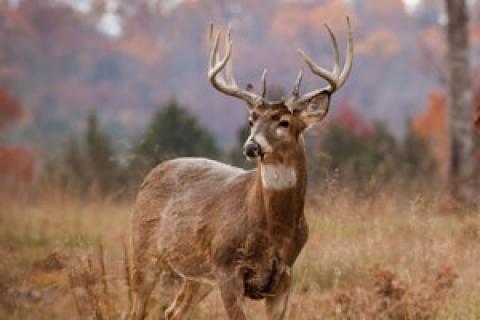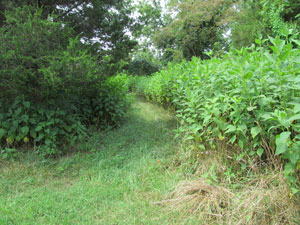
As hunters we mostly try to figure out where deer are moving and then set up an ambush along that route. But sometimes it's useful to turn that scenario around and actually make the deer move where you want them to (past your hunting stand) by gently altering their environment.
Here are six ways to manipulate the habitat that will encourage deer to move past you in good shooting range. They should only be done on your own property or land where you have advance permission from the owner. Deer may use the new paths immediately or it may take them a few weeks to get used to the changes and start walking the trails.
1. Lower a Strand of Fence Wire for Deer to Pass
This is one of the simplest alterations of all. While deer can easily jump fences, if there's a low spot where the wire is down, they'll head for it. With permission, when no livestock is in the area, push down the top strand of a barbed wire fence and fasten it to a lower strand with soft wire. Deer will soon discover the easy way to cross and cut a trail towards that spot. Pick a downwind location from the funnel in good shooting range and hang your stand.
2. Clear a Trail Through a Thicket for Deer to Follow

Dense, jumbled areas and overgrown briar patches are magnets for bucks. But busting through such areas isn't easy for them. Carve a trail and chances are they'll follow it.
Of course some knowledge of the local deer's movement patterns is a prerequisite. You have to know in general where they bed and major feed areas, so you can cut trails in the location and direction they want to travel.
This work may require a chain saw, bush hog or just a weed eater. Sometimes hand pruning shears or a machete will work. Don't carve a super-highway through the brush. Deer don't need that wide of a trail and might become suspicious. Instead, simply clear a wide enough path for one person to walk through.
3. Mow a Swath Through Switchgrass to Lead Deer
Native warm season grasses grow over 6 feet tall and offer great escape and security cover. Deer cut their own trails through the tall grass, but if you know some of the destinations they are heading for (crop field, food plot, etc.) you can mow a trail leading to that location and chances are they'll follow it. And you can mow that trail so it swings just upwind of the one good tree in the area that will work for a stand.
4. Roundup a Trail to Kill Vegetation for a Deer-Friendly Trail
Instead of weed eating or bush hogging, you can also create trails using herbicides such as Roundup (glyphosate). Spray the area where you want to make the path. When the vegetation dies, simply walk over it in rubber boots or drive over it in a four-wheeler to trample down a nice, deer trail.
5. Plant a Food Path to Your Deer Stand
Food plots provide vital nutrition for deer, but you can also use food plots strategically to draw deer to your stand.
 Pick an area where food is fairly scarce, but bucks tend to travel through as they leave bedding areas heading for major feed areas late in the day. Turn the soil or at least rake away leaves and debris, then sow a narrow strip of fast-growing seed such as rape, wheat, rye, oats, Austrian winter peas or fall mixtures from wildlife seed companies.
Pick an area where food is fairly scarce, but bucks tend to travel through as they leave bedding areas heading for major feed areas late in the day. Turn the soil or at least rake away leaves and debris, then sow a narrow strip of fast-growing seed such as rape, wheat, rye, oats, Austrian winter peas or fall mixtures from wildlife seed companies.
With a bit of rain, these will come up quickly. Within weeks you'll have a trail of lush, green deer food popping up. Bucks will walk the "food trail" as they head towards major evening feeding areas-right past your stand.
6. Build Brush Barriers to Block Routes to Keep Bucks Out
Saw down trash trees and hinge-cut others to block certain routes you don't want bucks to follow if it would take them away from your stand location. This is a simple way to drive them towards the route you want them to take so they walk within range of your ambush spot. The trees you hinge-cut will provide food for a year or more as they continue to grow. And the brush piles you create will also make excellent habitat for small game and turkeys. Not only is this a strategic move, it's also great habitat improvement.
- 11499 views

